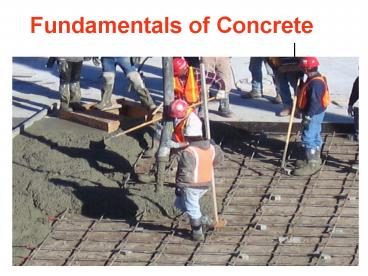Fundamentals of Concrete - PowerPoint PPT Presentation
1 / 30
Title:
Fundamentals of Concrete
Description:
PC Water Aggregates (FA & CA) Voids. Heterogeneous and isotropic ... Glass 'alkali attack' Steel. Fibers. Synthetic 1 to 1.5 lb per cu. yd. polypropylene ... – PowerPoint PPT presentation
Number of Views:305
Avg rating:3.0/5.0
Title: Fundamentals of Concrete
1
Fundamentals of Concrete
2
There is No such Animal as a Cement _at_!
- Composition of Concrete
- PC Water Aggregates (FA CA) Voids
- Heterogeneous and isotropic
- Wood is homogeneous and non-isotropic
- Steel is homogeneous and isotropic
- 1 bag of PC weighs 94
- Properties of Fresh Concrete and Hardened Concrete
3
Fresh Properties - ASTM
- Slump
- Temperature
- Density Yield
- Air Content
- Time of Setting
4
Hardened Properties - ASTM
- Strength
- Air Content
- Density, Absorption and Voids
- Volume Change
- Durability
- Permeability
5
How does Concrete Get Its Strength
- PC water hydration reaction gt GLUE Heat
- Cementitious material literally glues all of the
inert (non-reactive) aggregates together to
produce a solid load bearing mass that we call
PCC - Strength is inversely proportional to the
water-to-cement ratio
6
Strength vs. w/c Ratio for PCC
Strength, psi
w/c ratio
7
Whats Important
- Good quality materials
- PC, water, coarse aggregate, and fine aggregate
- Proper Proportioning of the Materials
- Proper Mixing
- Placing and Finishing
- Proper Curing
- QC Testing
8
How about the Costs?
9
Ethics and Safety
- PC The most expensive component of the mix
- Dont get shorted on this material
- Life Cycle Costs vs. Material Costs
- PCC inherently a safe material considering
- Highly alkaline
- Eye protection
- Skin irritations
- Heavy 150 pcf or about 2 tons pcy
10
Other Types of Concrete
- Lightweight Concrete
- Structural and Non-structural (120 50 pcf)
- High Density Concrete (400 pcf)
- Mass Concrete
- Pre-placed Concrete
- No Slump Concrete
- Roller-Compacted Concrete
- Shotcrete (Wet and Dry)
11
PC does NOT come from Portland Oregon
- History
- Portland Cement
- Limestone Sand Clay Iron ore heat(1500 C)
PC Clinker Grinding PC powder - Dry process and wet process ( p. 22 and 23)
- Hydraulic Cement hardens in air and under water
- Types I, II, III, IV and V
- IA and IIA blended with air-entraining agents
- White Portland Cement
12
(No Transcript)
13
(No Transcript)
14
Blended Cements
- Blended Cements
- Type IP or P Portland Pozzolan Cement
- Moderate heat and moderate sulfate resistance
- Class C Fly Ash 15 to 40
- Class F Fly Ash 15 to 25 (FDOT)
- Type IS or S - Portland Blast Furnace Slag Cement
- Low Heat (FDOT)
- 25 70
15
Other Types of Cement
- High Early Strength Cements - RR
- Calcium Sulfoaluminate Rapid Set
- Calcium Aluminate Cements- Cement Fondu
- Magnesium Phosphate SET-45
- Oil-Well Cements
- Acid Resistant Cements
- Silicate based
- Sulfur
16
Mixing Water
- Potable
- ie. Water suitable for drinking
- Chloride lt 0.05
- Sulfate lt 0.08
- Organic salts lt 0.05
- sugar
17
Aggregates
- Coarse Aggregate
- Retained on 4 Sieve
- Igneous, Sedimentary and Metamorphic rock
- Granite
- Limestone
- River gravel
18
CA continued
- Maximum size from 6-in to 3/8-in
- Max size governed by ACI code
- Graded down to 4 sieve according to ASTM C136
- Common gradations, 467, 57, 67 and 89
- 1-1/2 in max, 1-in max, ¾-in max, and 3/8-in max
respectively - Aggregate Testing according ASTM Standards
- TABLE 5.2 (Page 81)
19
Aggregates
- Fine Aggregate
- Passing 4 Sieve ¼-in.
- Natural Siliceous and Crushed Limestone
- Graded according to ASTM C33
- See next slide
- Fineness modulus
- Indication of the average particle size (2.0 to
3.0) - Fine Aggregate Testing according to ASTM
- TABLE 5.2 (Page 81)
20
Fine Aggregate Grading Limits
21
Fine Aggregate
FDOT
passing
ASTM
200
4
Sieve Size
22
Fineness Modulus Calculation
23
Recycled Concrete Aggregate
- Old concrete that has been removed and crushed to
produce aggregate. - Coarse aggregate in new concrete
- Fine aggregate in new concrete
- Best combination is CA with natural fine
aggregate - Good strength
- Drying shrinkage problem
- Base-coarse replacement for natural limestone
24
Mineral Admixtures
- Pozzolanic (cement replacement)
- Class F Fly ash 15 to 25 bwc
- Class C Fly ash 15 to 40 bwc
- Blast Furnace Slag (cement replacement)
- 25 to 70 bwc
- Silica Fume (cement addition)
- 6 to 12 bwc
25
Chemical Admixtures ASTM C-494 (Ch. 6)
- Table 6-1
- Water Reducing Type A
- Set Retarding Type B
- Set Accelerating Type C
- Water Reducer-Set Retarding Type D
- Water Reducer-Accelerating Type E
- High Range Water Reducers Type F
- HR Water Reducer-Set Retarding -Type G
26
Fibers (see Table 7-1)
- Natural Egyptian pyramids
- Straw, bamboo, and wood
- Glass alkali attack
- Steel
- Fibers
- Synthetic 1 to 1.5 lb per cu. yd.
- polypropylene
- nylon
27
Air-Entraining Agents ASTM C260 (Ch. 8)
- Admix that produces stable bubble system
- Liquid and solid
- Low dosage rates relative to other chemical
admixtures (0.005 to 0.05 bwc). - Increase in durability _at_freeze/thaw
- Reduces compressive strength
- 3-5 per percent of entrained air
28
(No Transcript)
29
(No Transcript)
30
(No Transcript)































